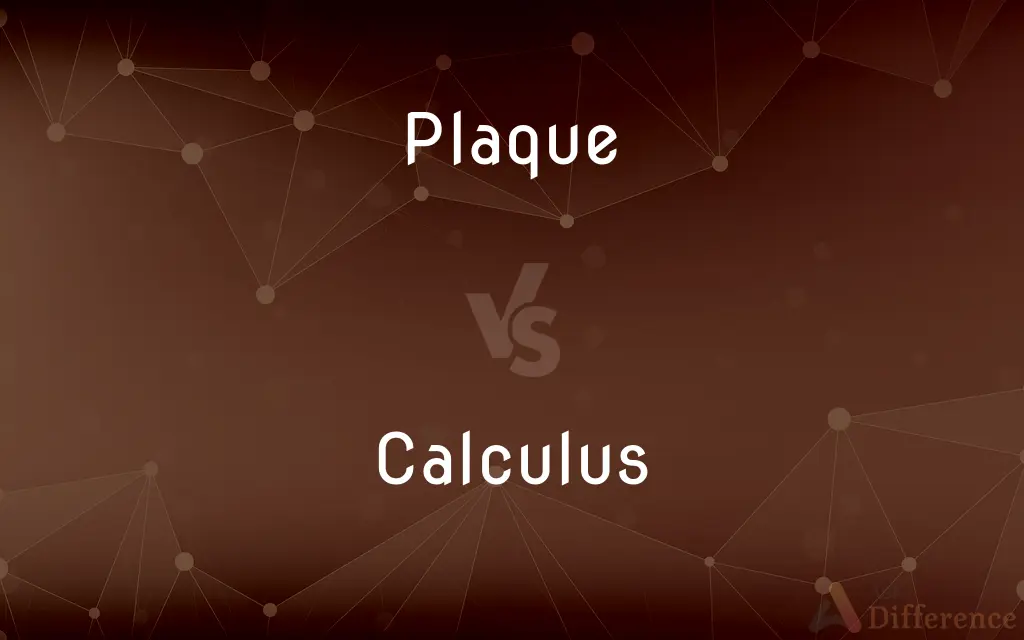Plaque vs. Calculus — What's the Difference?
By Urooj Arif & Fiza Rafique — Published on March 4, 2024
Plaque is a soft, sticky film that accumulates on teeth, while calculus, or tartar, is hardened plaque that attaches to the enamel and can only be removed professionally.

Difference Between Plaque and Calculus
Table of Contents
ADVERTISEMENT
Key Differences
Plaque is a colorless or pale yellow film that continuously forms on teeth. It's composed of bacteria, saliva, and food particles. If not removed regularly through brushing and flossing, it can lead to dental issues like cavities and gum disease. Calculus, on the other hand, is plaque that has mineralized on the teeth over time, becoming hard and firmly attached to the tooth surface. Unlike plaque, calculus cannot be removed with regular home dental care and requires professional dental cleaning.
Plaque begins forming on the teeth soon after eating or drinking anything sugary or starchy. It's easily removable by daily brushing and flossing. Calculus, however, develops when plaque is left on the teeth for a period of time, allowing it to harden. This process is facilitated by the minerals in saliva.
The presence of plaque can lead to tooth decay and gum inflammation due to the acidic byproducts produced by the bacteria it contains. In contrast, calculus provides a rough surface that enhances bacterial attachment, further protecting bacteria from removal and exacerbating gum and periodontal diseases.
Managing plaque involves regular oral hygiene practices, including brushing twice a day, flossing daily, and using mouthwash. To prevent calculus formation, it's important to not only maintain these practices but also to visit a dentist regularly for cleanings, as once plaque turns into calculus, professional intervention is necessary.
Both plaque and calculus play significant roles in dental health, with plaque being the initial form that can evolve into calculus if oral hygiene is neglected. Understanding the differences between them is crucial for effective dental care and preventing more serious dental issues.
ADVERTISEMENT
Comparison Chart
Composition
Soft, sticky film of bacteria, saliva, and food particles
Hardened plaque, mineralized by calcium and phosphate from saliva
Visibility
Colorless or pale yellow, harder to see
More visible, often yellow or brown
Removal
Can be removed with brushing and flossing
Requires professional dental cleaning
Formation Time
Forms quickly, within hours after eating
Takes longer, mineralizing over days to weeks
Impact on Dental Health
Leads to cavities and gum disease if not removed
Provides a rough surface that exacerbates gum disease, cannot be removed by brushing
Compare with Definitions
Plaque
A soft, sticky film on teeth.
Regular brushing helps remove plaque and prevent cavities.
Calculus
Hardened dental plaque.
Calculus forms when plaque is not removed and hardens on the teeth.
Plaque
Can lead to tooth decay if not removed.
Failure to brush daily allows plaque to damage tooth enamel.
Calculus
Requires dental intervention for removal.
Only a dentist can remove calculus during a cleaning.
Plaque
Composed of bacteria and food particles.
Eating sugary foods can increase plaque buildup.
Calculus
Can lead to gum disease.
Calculus build-up can cause gum inflammation and disease.
Plaque
Forms quickly after eating or drinking.
Plaque can start forming on teeth 20 minutes after eating.
Calculus
Visible and harder than plaque.
Tartar is often visible at the base of the teeth as a yellow or brown deposit.
Plaque
Preventable with good oral hygiene.
Flossing daily helps control plaque formation.
Calculus
Preventable with regular dental care.
Regular dental check-ups can prevent calculus formation.
Plaque
A flat plate, slab, or disk that is ornamented or engraved for mounting, as on a wall for decoration or on a monument for information.
Calculus
A stony concretion that forms in a bodily organ.
Plaque
A biofilm of bacteria in a matrix of polysaccharides and other substances on the surface of a tooth or teeth.
Calculus
Any solid concretion, formed in any part of the body, but most frequent in the organs that act as reservoirs, and in the passages connected with them; as, biliary calculi; urinary calculi, etc.
Plaque
An accumulation in artery walls made up of macrophage cells and debris containing lipids, (cholesterol and fatty acids), calcium, and connective tissue; an atheroma.
Calculus
An incrustation that forms on the teeth and gums
Plaque
An accumulation of biofilm, or bacteria, on teeth, which may develop into dental calculus (tartar).
Common Curiosities
Why is calculus harder to remove than plaque?
Calculus is plaque that has hardened over time and adhered to the tooth enamel, requiring professional tools for removal.
What is plaque?
Plaque is a soft, sticky film that forms on the teeth, composed of bacteria, saliva, and food particles.
How does calculus affect gum health?
Calculus provides a rough surface for bacteria to adhere to, worsening gum and periodontal diseases.
Is it possible to prevent plaque and calculus?
Good oral hygiene practices can prevent plaque, and regular dental visits can help prevent calculus formation.
What happens if plaque is not removed?
If not removed, plaque can lead to cavities, gum disease, and eventually harden into calculus.
What is calculus?
Calculus, or tartar, is hardened plaque that has mineralized on the teeth and requires professional removal.
How can plaque be removed?
Plaque can be removed through regular brushing, flossing, and the use of mouthwash.
Can plaque lead to tooth decay?
Yes, plaque can lead to tooth decay and gum disease if not properly removed.
Does diet affect plaque and calculus formation?
Yes, diets high in sugars and starches can increase plaque formation, which can lead to calculus if not removed.
How quickly can plaque form on teeth?
Plaque can begin forming on teeth 20 minutes after eating or drinking.
Can everyone get calculus on their teeth?
Yes, anyone can get calculus on their teeth if plaque is not regularly removed.
How often should teeth be cleaned to prevent calculus?
Professional dental cleanings are recommended at least twice a year to prevent calculus formation.
Can mouthwash remove plaque?
Mouthwash can help reduce plaque but should be used in conjunction with brushing and flossing.
Is calculus removal painful?
Calculus removal might be uncomfortable for some, but dental professionals use techniques to minimize discomfort.
What is the main difference between plaque and calculus?
The main difference is that plaque is a soft film that can be removed with brushing, while calculus is hardened and requires professional cleaning.
Share Your Discovery

Previous Comparison
Ski Pants vs. Snowboard Pants
Next Comparison
Amlodipine vs. Amlodipine BesylateAuthor Spotlight
Written by
Urooj ArifUrooj is a skilled content writer at Ask Difference, known for her exceptional ability to simplify complex topics into engaging and informative content. With a passion for research and a flair for clear, concise writing, she consistently delivers articles that resonate with our diverse audience.
Co-written by
Fiza RafiqueFiza Rafique is a skilled content writer at AskDifference.com, where she meticulously refines and enhances written pieces. Drawing from her vast editorial expertise, Fiza ensures clarity, accuracy, and precision in every article. Passionate about language, she continually seeks to elevate the quality of content for readers worldwide.
















































